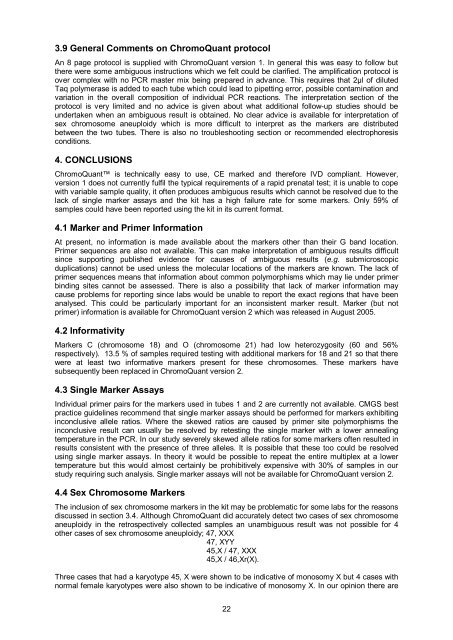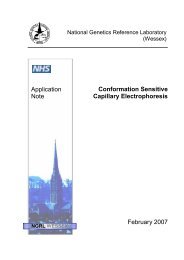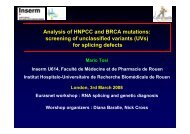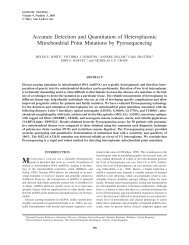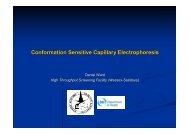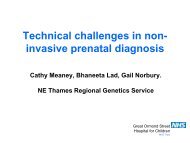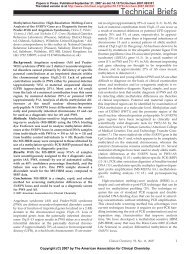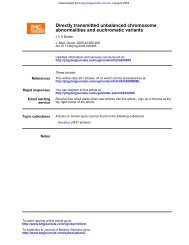(Wessex) Technology Assessment ChromoQuant⢠(version 1)
(Wessex) Technology Assessment ChromoQuant⢠(version 1)
(Wessex) Technology Assessment ChromoQuant⢠(version 1)
You also want an ePaper? Increase the reach of your titles
YUMPU automatically turns print PDFs into web optimized ePapers that Google loves.
3.9 General Comments on ChromoQuant protocolAn 8 page protocol is supplied with ChromoQuant <strong>version</strong> 1. In general this was easy to follow butthere were some ambiguous instructions which we felt could be clarified. The amplification protocol isover complex with no PCR master mix being prepared in advance. This requires that 2μl of dilutedTaq polymerase is added to each tube which could lead to pipetting error, possible contamination andvariation in the overall composition of individual PCR reactions. The interpretation section of theprotocol is very limited and no advice is given about what additional followup studies should beundertaken when an ambiguous result is obtained. No clear advice is available for interpretation ofsex chromosome aneuploidy which is more difficult to interpret as the markers are distributedbetween the two tubes. There is also no troubleshooting section or recommended electrophoresisconditions.4. CONCLUSIONSChromoQuant is technically easy to use, CE marked and therefore IVD compliant. However,<strong>version</strong> 1 does not currently fulfil the typical requirements of a rapid prenatal test; it is unable to copewith variable sample quality, it often produces ambiguous results which cannot be resolved due to thelack of single marker assays and the kit has a high failure rate for some markers. Only 59% ofsamples could have been reported using the kit in its current format.4.1 Marker and Primer InformationAt present, no information is made available about the markers other than their G band location.Primer sequences are also not available. This can make interpretation of ambiguous results difficultsince supporting published evidence for causes of ambiguous results (e.g. submicroscopicduplications) cannot be used unless the molecular locations of the markers are known. The lack ofprimer sequences means that information about common polymorphisms which may lie under primerbinding sites cannot be assessed. There is also a possibility that lack of marker information maycause problems for reporting since labs would be unable to report the exact regions that have beenanalysed. This could be particularly important for an inconsistent marker result. Marker (but notprimer) information is available for ChromoQuant <strong>version</strong> 2 which was released in August 2005.4.2 InformativityMarkers C (chromosome 18) and O (chromosome 21) had low heterozygosity (60 and 56%respectively). 13.5 % of samples required testing with additional markers for 18 and 21 so that therewere at least two informative markers present for these chromosomes. These markers havesubsequently been replaced in ChromoQuant <strong>version</strong> 2.4.3 Single Marker AssaysIndividual primer pairs for the markers used in tubes 1 and 2 are currently not available. CMGS bestpractice guidelines recommend that single marker assays should be performed for markers exhibitinginconclusive allele ratios. Where the skewed ratios are caused by primer site polymorphisms theinconclusive result can usually be resolved by retesting the single marker with a lower annealingtemperature in the PCR. In our study severely skewed allele ratios for some markers often resulted inresults consistent with the presence of three alleles. It is possible that these too could be resolvedusing single marker assays. In theory it would be possible to repeat the entire multiplex at a lowertemperature but this would almost certainly be prohibitively expensive with 30% of samples in ourstudy requiring such analysis. Single marker assays will not be available for ChromoQuant <strong>version</strong> 2.4.4 Sex Chromosome MarkersThe inclusion of sex chromosome markers in the kit may be problematic for some labs for the reasonsdiscussed in section 3.4. Although ChromoQuant did accurately detect two cases of sex chromosomeaneuploidy in the retrospectively collected samples an unambiguous result was not possible for 4other cases of sex chromosome aneuploidy; 47, XXX47, XYY45,X / 47, XXX45,X / 46,Xr(X).Three cases that had a karyotype 45, X were shown to be indicative of monosomy X but 4 cases withnormal female karyotypes were also shown to be indicative of monosomy X. In our opinion there are22


